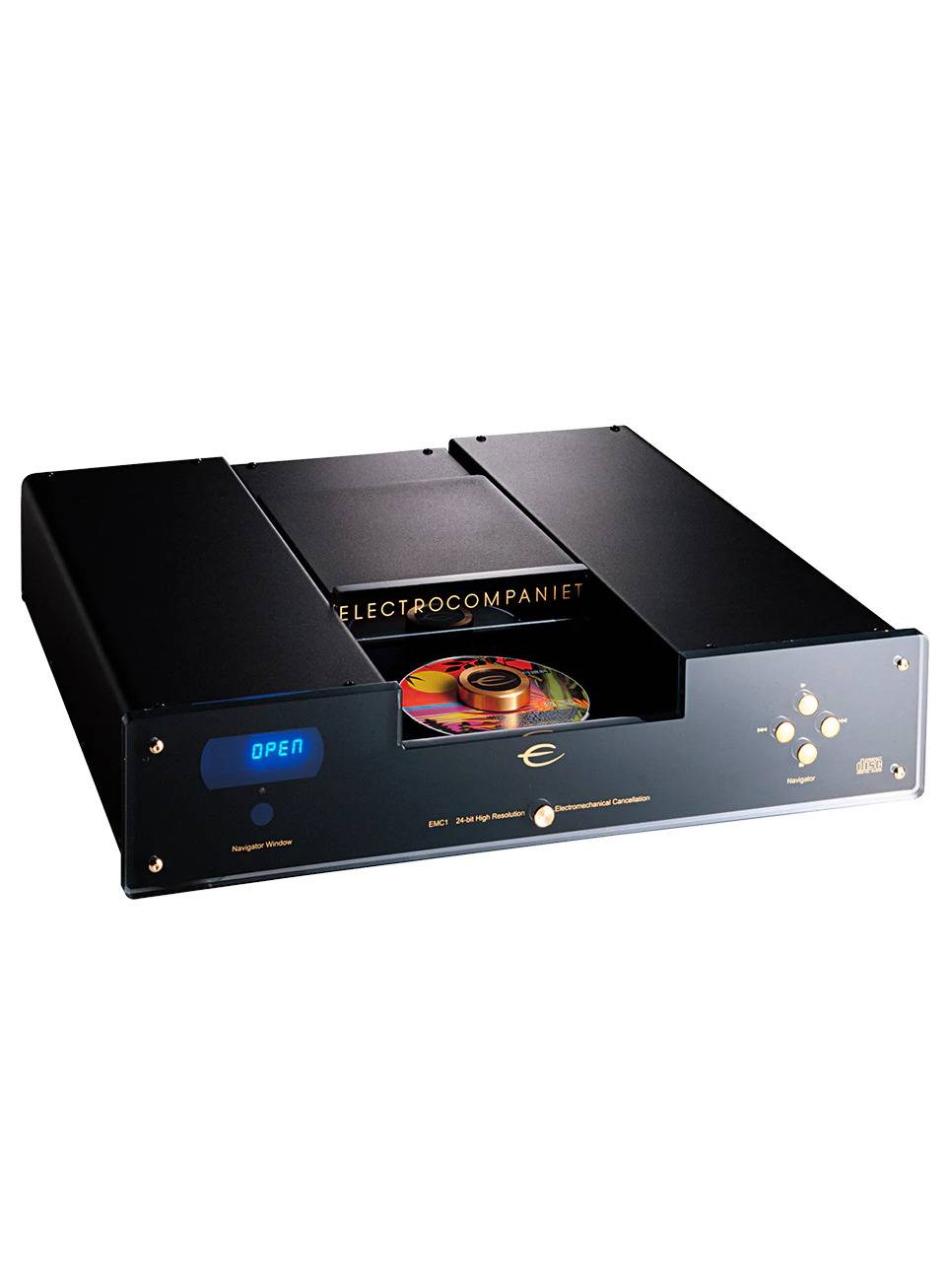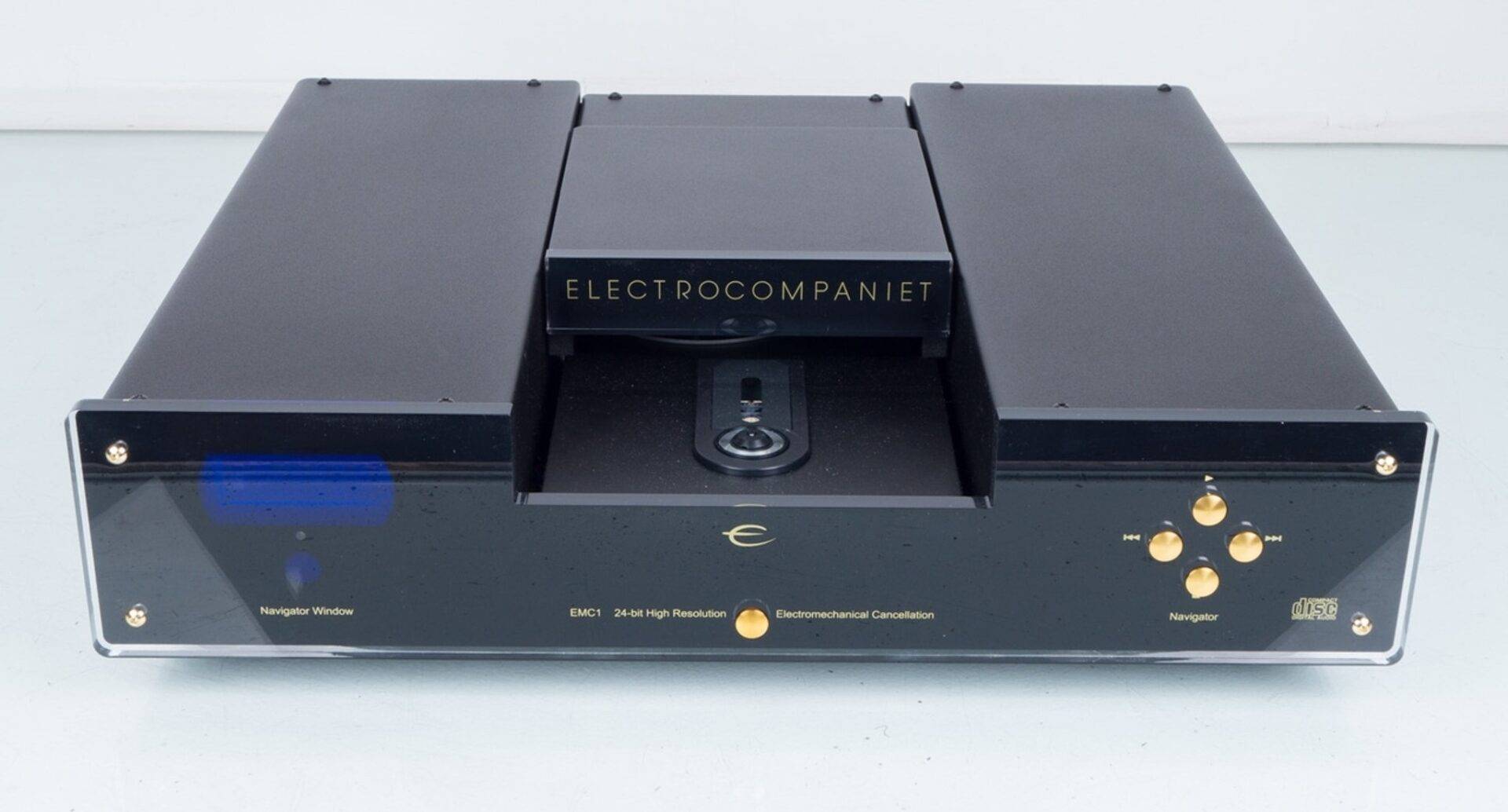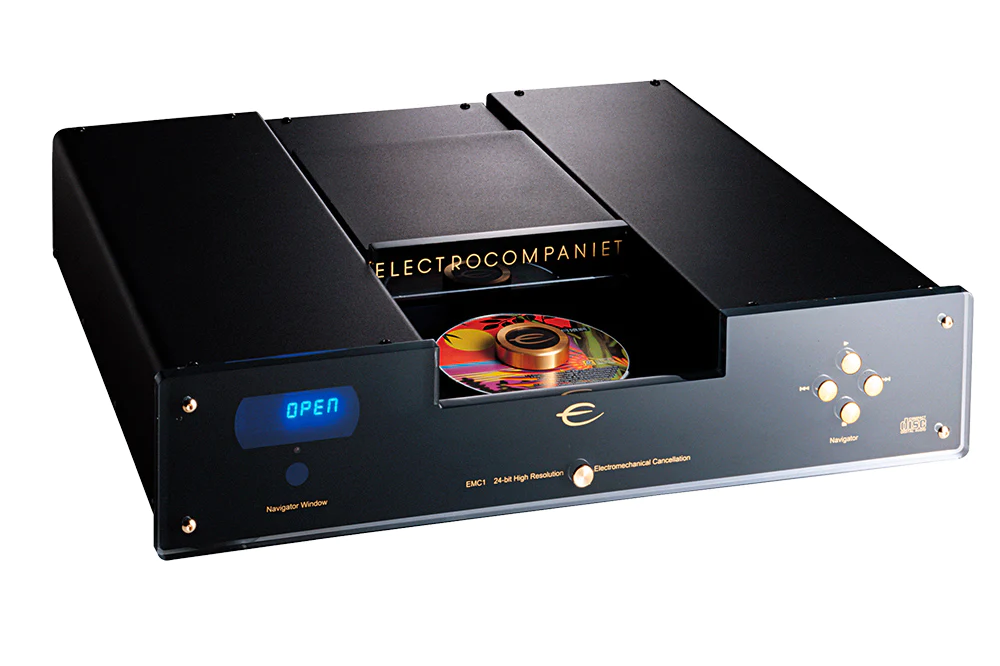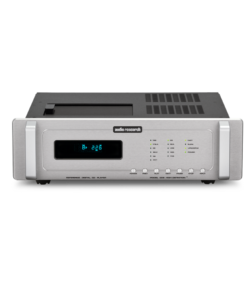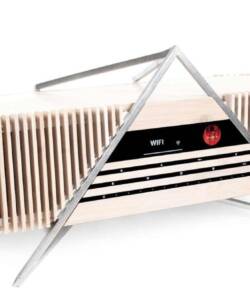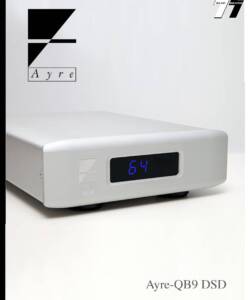Electrocompaniet EMC-1UP CD Player
Original price was: R98,000.00.R19,800.00Current price is: R19,800.00.
Electrocompaniet EMC-1UP CD Player Reviewed

Electrocompaniet EMC-1UP CD Player Reviewed
Terry London has always had a great passion for music, especially jazz, and has amassed a collection of over 7,000 CDs covering the history of this uniquely American art form. Even in his teenage years, Terry developed a passion for auditioning different systems and components to see if they could come anywhere close to the sound of live music, and has for the last forty years had great fun and pleasure chasing this illusion in his two-channel home system.
Terry is a practitioner of Rational Emotive Behavior Therapy by day, and runs the Chicago Institute for REBT. He has also authored nine books on this of type psychotherapy and education.

For any high-end company to keep the same reference piece in production for more than a few years is rare. Yet, Electrocompaniet has been manufacturing the EMC-1UP CD player for over ten years. This Red Book CD player was revised from the original EMC-1 to the EMC-1UP when 24-bit / 192 KHz up-sampling technology was implemented in 2001. The price of this player is $7,295, but is it is worth the high price of admission in today’s throwaway component market?
Additional Resources
• Read more source component reviews by HomeTheaterReview.com’s writers.
• Find a receiver to pair with the EMC-1UP in our AV Receiver Review section.
The EMC-1UP is a top-loading player that uses the latest version of the Phillips CD Pro Top-Loading Drive unit. It is visually quite attractive looking with its acrylic front and gold and black scheme. The EMC-1UP can be controlled with its front panel buttons or with its dedicated remote control. It has the size, with a width of 19 inches, a depth 17.3 inches and a height of four and a half inches with a weight 44 pounds, to possibly pass as a power amplifier -yet we’re talking about a CD player. The EMC-1UP has both XLR and single ended outs, along with a single ended out for its transport.
The build quality is superlative inside and out. There are two special aspects that are applied to the EMC-1 approach to getting the most sonically out of the red book format. First, Electrocompaniet has developed a proprietary “mechanical filter” that dramatically reduces internal and external vibration from entering the laser pick-up. Secondly, the EMC-1UP features this company’s latest, fully balanced symmetrical circuit design powered by a Floating Transformer Technology power supply.
If you are looking for a CD player that gives you powerful dynamics, micro-details, resolution, and a great large and layered soundstage, the EMC-1UP might be just what you are looking for. What I find quite special, without a tube in sight, is how the EMC-1UP offers the timbres, warmth, and palpability of an analog front end without giving up any of the above stated sonic virtues. To use very subjective terms – this player is one of the most “musical” and “natural” CD players I have ever heard.
Read about the high points and low points of the EMC-1UP CD player on Page 2.
High Points
• Superlative is the only word I can use to describe the EMC-1UP’s build quality both internally and externally. It’s pure audio jewelry.
• The EMC-1UP can be used either in either balanced or unbalanced mode, which is very nice these days.
• The EMC-1UP can be used as a reference level transport with other DACs or on its own, making it a versatile high-end source component.
• The EMC-1UP offers up the resolution of digital with analog-like timbres and warmth.
Low Points
• The EMC-1UP has no USB input so it cannot be used as a DAC for other digital sources or your computer.
• The EMC-1UP is a strictly Red Book CD player meaning it wont’ play SACDs or any of the other high-resolution formats. Lesser priced players like Oppo Digital’s BDP-95 play all disc formats (outside of HD DVD) including Blu-ray, SACD, DVD-Audio and more, including high end DACs internally for less money.
• Since the EMC-1UP is a top-loading CD player it must be given plenty of clearance within your rack to facilitate such a loading procedure. I placed mine on the top shelf of my rack to skirt any issues.
• The EMC-1UP’s remote is quite functional; however it is made of plastic and far below the build quality of the player.
Competition and Comparison
Based on price and performance, the major competitors at this high level of CD players would be either the Marantz UD9004 ($5,999) or the Esoteric X-05 ($6,500). Both these players offer excellent build quality and top-notch sonic performance. Both of these players have one option that the EMC-1UP does not offer – they both play SACDs along with Red Book CDs. If your music collection, like mine, is composed of only Red Book CD’s then I would still pick the EMC-1UP for its sonic performance on this format. However, if you have a large collection of SACDs along with Red Book CDs you might want to audition one of these other terrific players.
For more on CD players and other audiophile and home theater source components please check out Home Theater Review’s Source Components page.
Conclusion
I have, over the last five years, auditioned over ten CD players, along with many highly regarded DACs, and still find the Electrocompaniet EMC-1UP ($7,295.00) to be one of the most “musical” and enjoyable CD players currently on the market. It offers top-notch build quality and some very interesting technological innovations. Most importantly, it offers natural beautiful timbres that are free from any digital artifacts. While there is no “BEST” in high-end audio because of personal taste and system synergy, the EMC-1UP is a terrific CD player, and I hope you get to hear it sometime in the future.
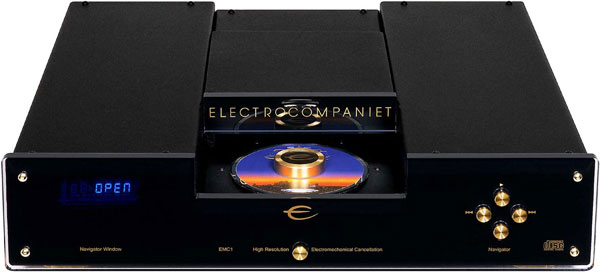 I have often read CD player reviews that imply that the sonic differences between CD players are very minimal. This has not been my experience. It is true that this may have generally been the case in 1990, but things changed by the late 1990’s, and the last 5-7 years have seen an amazing variety of players. So many that even veterans of digital audio can’t keep up. For example, I have owned over a dozen different CD players, reviewed four (including my own Esoteric front end) since joining the Dagogo staff, and extensively demo’d (in my own system) a dozen others. Included are the Lindemann 820S SACD Player (January 2009 Edition of Dagogo), the EMM Labs CDSA CD/SACD player, Oracle CD 2500 (August 2006 edition of Dagogo), Music Hall Maverick SACD player (May 2007 edition of Dagogo), Levinson 39S, the Cary 306/200, the Electrocompaniet EC-1 and several custom-modded DVD players, as well as EAD transports and DACs.
I have often read CD player reviews that imply that the sonic differences between CD players are very minimal. This has not been my experience. It is true that this may have generally been the case in 1990, but things changed by the late 1990’s, and the last 5-7 years have seen an amazing variety of players. So many that even veterans of digital audio can’t keep up. For example, I have owned over a dozen different CD players, reviewed four (including my own Esoteric front end) since joining the Dagogo staff, and extensively demo’d (in my own system) a dozen others. Included are the Lindemann 820S SACD Player (January 2009 Edition of Dagogo), the EMM Labs CDSA CD/SACD player, Oracle CD 2500 (August 2006 edition of Dagogo), Music Hall Maverick SACD player (May 2007 edition of Dagogo), Levinson 39S, the Cary 306/200, the Electrocompaniet EC-1 and several custom-modded DVD players, as well as EAD transports and DACs.
My current front-end is an Upgrade Company-modded Esoteric P-70/D-70 combo (see my review in the December 2008 issue of Dagogo), connected by two Transparent Reference AES/EBU and one Transparent Reference BNC digital cable, mounted on a Target VW-2 wall-mounted dual turntable shelf, and powered by way of a dedicated outlet connected by Lessloss DFPC Signature Power Cords (review to come). I really love this front-end, but I will tell you frankly that I would not feel this much affection for it without David Schulte’s (the Upgrade Company) mods. His mods improved several things, but for my taste, the main improvement was the body and warmth added to the presentation. This body and warmth are not, in my opinion, artificial coloration. Instead, they brought the Esoteric combo closer to “live”.
The absence of sufficient body and warmth in digital components has been one of the chief complaints (there have been others) made about digital. You can attempt to compensate through your selection of preamp, amp or cables, but this is an extremely dangerous approach where you risk cobbling together a system that addresses component shortcomings by adding coloration. In my opinion, you need to fundamentally love both your speakers and your front-end before you tweak the sound with other components.
Realizing this, designers turned to tubes, upsampling, oversampling, and different digital formats (SACD and DVD Audio) in an effort to address these and other digital issues. Electrocompaniet was an early adapter of upsampling, but there was clearly more than upsampling to what they were doing. My own Esoteric is an upsampling player, but even after the mods it doesn’t have the body and weight produced by the EMC 1 UP. In fact, as you will see below, the EMC 1 UP produces the sort of full-bodied sound that is normally associated with tubed players, but without the hassle of tubes. Read on.
Design
The EMC 1 UP is a top loader with a sliding, rather than a hinged, door. Most top loaders must be placed on the top shelf so that there is room for the hinged door to swing open. This may not be important in some systems, but drawer-style players and transports can give you more flexibility in placement, especially if you also have a turntable, which definitely needs to go on the top shelf of your rack. The EMC 1 UP’s top slides straight back, opening not only the top of the unit, but also sliding back part of the top of the central face of the player so that you can put the disc in on a middle shelf that has enough clearance. Top off the disc with the supplied magnetic puck, close the sliding top, and you’re ready to go.
The EMC 1 uses a Philips CDM-PRO 2 transport. The CDM-PRO mechanism and DSP board are housed in a rectangular metal block consisting of 4 sheets of metal alloy with soft rubber coupling feet. This electro-mechanical damping system is designed to isolate the transport’s laser mechanism from vibrations. The EMC 1 employs 24/192 kHz DACs and all circuits are fully balanced and symmetrical. Two separate transformers power the digital, analogue, drive mechanism and fluorescent display. The power supply is designed using Electrocompaniet’s Floating Transformer Technology, which is also used in Electrocompaniet amps. The whole player stands on three triangularly-placed feet. You can get more details and information from Electrocompaniet’s website: www.electrocompaniet.com.
Setup
Setup was straightforward. I only used the balanced outputs, which is what Electrocompaniet recommends, and ran balanced throughout the entire equipment chain. For my first listening session I used Silent Source Signature XLRs to connect the EMC 1 UP to the pre and powered it by a regular LessLoss DFPC. In later listening sessions I substituted the fabulous Silent Source Music Reference XLR interconnects and LessLoss DFPC Signature power cord. Over the course of several listening sessions I played the EMC 1 UP through three different preamps: the MBL 6010D, the Pass XP-20 and the Shengya CS-6. Amps included Electrocompaniet Nemo monoblocks and Shengya PSM-600, and the speakers were B&W 800D and Janszen Model One electrostatics.
First Impressions
I first listened to the EMC 1 UP without the Spider Clamp. I could immediately hear the voicing that I love in the Electrocompaniet Nemo monoblocks – a detailed sound with excellent body and natural-sounding tonal richness. Well-recorded piano had concert hall clarity, cymbals were crisp and clear, the wooden-bodied sound of acoustic guitars was clearly discernible, and brass had bite without harshness. The weight and richness of acoustic bass was excellent, and the bass in general was among the more realistic I’ve heard, while the top-end was extremely pleasing and listenable, with good extension. I don’t like to make assumptions based on reputation, but these initial auditions immediately demonstrated that the EMC 1 UP deserves its reputation as a top digital source – extremely enjoyable from the first listen, with no major weaknesses and definitely competitive with players up to $10,000 and some above that price range. As a result, all my comments about “weak” points are made in the context of comparisons to the top digital components I have heard.
Once I shifted my listening into “analytical” mode, I concluded that the EMC 1 UP’s “weaknesses” relative to the best digital I’ve heard were: 1) average focus and performer separation, and 2) good but not great dynamics and speed. My modified Esoteric clearly bested the EMC 1 UP in this regard, and seemed to match my expectation that $19,000 worth of digital separates and high-end digital cables would beat a $7,290 one-box player. However, system synergy is such a major factor in evaluating components, that it is a big mistake to make a final judgment by only listening in one system configuration. When playing with audio equipment you sometimes get the unexpected, and this occurred when I made a few changes. I started with Electrocompaniet’s Spider Clamp.
Adding the Spider Clamp and playing with the Millennium CD mat
The Spider Clamp is designed to help center and stabilize the disc in the transport mechanism. However it does this, it clearly works. Adding the Spider Clamp improved definition, solidity and performer placement. There was in immediate improvement in focus and separation, thus addressing one of the two weaknesses I mentioned above and bringing the EMC 1 UP’s soundstaging and performer placement much closer to that of my Esoteric combo. A few listening sessions confirmed that the Spider Clamp is essential for getting the best out of the EMC 1 UP. The improvement in a high-end/high-resolution system was clearly worth the additional cost of the Spider Clamp.
Even though my Esoteric P-70 transport uses a VRDS mechanism that will not accommodate a CD mat, I have a Millennium CD mat (February 2009 edition of Dagogo) which I use with great success in my other CD and DVD players. As an experiment, I used the Millennium CD Mat in conjunction with the Spider Clamp. This produced even better results than just the Spider Clamp by itself. For example, Steely Dan’s My Old School had plenty of body without either the Spider Clamp or the Millennium CD mat, but exhibited a bit of sluggishness and a slightly congealed soundstage. Adding the Spider Clamp tightened everything up nicely without any loss of body or richness, making the presentation more lively, and added separation between performers. However, using the Millennium CD mat in conjunction with the Spider Clamp tightened up every note even more, turned that part of the song into a true staccato passage and brought out nuances that I did not hear on the first go-around, making it much more difficult to distinguish the EMC 1 UP from my Esoteric’s impactful rendering of that tune.
Enter the Silent Source Music Reference interconnect and LessLoss DFPC Signature power cord
I got these cables after I had evaluated the EMC 1 Up with the Spider Clamp and Millennium mat. Naturally, I put them on my Esoteric front-end first. I was very impressed about how each of these cables audibly notched everything up in my Esoteric combo. I fully expected similar improvements when I decided to try them on the EMC 1 UP. However, I also expected these fine cables to further clarify how much better the Esoteric combo was than the EMC 1 UP. After all, my experience had been that the best components also get the most improvement from upgraded cables. I was in for a surprise. The insertion of these two cables had more effect on the EMC 1 UP, and made it much more difficult to detect differences between the two front-ends. See what I mean by unexpected results when system synergy is taken into account?
Playing music through the EMC 1 UP, fed by the LessLoss DFPC Signature and tethered to the MBL 6010D via the Silent Source Music Reference XLR became addicting. I could still hear some shortcomings when I listened in “analytical” mode and compared the sound to the “best” digital I’ve heard, but I simply couldn’t sustain listening in analytical mode for very long. It was just too enjoyable to simply let the EMC 1 UP do its thing. For example, “Respect Yourself”, on The Very Best of Robert Palmer, is an OK recording, but depending on the character of your system, it can sound energetic and bouncy but too thin, or rich and full-bodied but sluggish: the “You can never be too rich or too thin” adage definitely does not apply to musical reproduction. The EMC 1 UP got it just right.
The conclusion I reached from this experience was that the initial impression of a weakness in dynamics and speed is misleading, and that the EMC 1 UP clearly has the capacity for very good speed and dynamics, and you simply need to intelligently select a power cord and balanced interconnect that maximizes system synergy.
A Note About Associated Equipment
Most of my listening was done through my own MBL 6010D preamp, Electrocompaiet Nemo monos and B&W Nautilus 800D. However, I had the opportunity to review JansZen Audio’s Model One electrostatics during the time that I had the Electrocompaniet EMC 1 UP in my system. Electrostatics are extremely fast and detailed, so I thought that they could be a great match for the EMC 1 UP. I also had the Shengya CS-6/PSM-600 tubed pre/solid state monoblock combo and thought that they could all be a good match. It turned out that those components together were an excellent match for the EMC 1 UP. I would definitely recommend that electrostatic owners check out the EMC 1 UP as an option for a front-end, and that EMC 1 UP owners see what their players sound like with the wide soundstage and speed of electrostatics. Enough said.
Conclusion
One of the few downsides to reviewing audio equipment is the need to be analytical and brutally analyze a component’s weaknesses. Once you’ve gone through that exercise it can be difficult to listen to the component without focusing on its “failings”. This never occurred with the EMC 1 UP, which was emotionally involving and easy to listen to for hours on end. Did the $7,500 EMC 1 UP with Spider Clamp outplay my modded Esoteric P-70/D-70 front-end, which retailed for $15,000 5 years ago, not to mention the three transparent Reference digital cables retailing for $3600? Objectively, looking at isolated “audiophile” qualities, no. Low frequencies were a touch less firm, affecting PRAT on lively passages. Placement of instruments & vocals in the sound-stage was fuzzier than with my Esoteric, and at times lacked the focus I’ve grown accustomed to. Subjectively, however, the EMC 1 UP sure as hell sounded good. In fact, there was a rightness to the overall presentation that repeated itself on every disc played. I think that the only listeners who might feel differently would be those who love an analytical CD player and/or one which produces ephemeral images of ghostlike performers.
System matching will help you get the absolute best out of the EMC 1 UP. This was especially true when it was matched with superior cables and dynamic components. Of the components I had on hand at the time, using the EMC 1 UP as the front-end for: (1) the Pass Labs XP-20 preamp (see the July 2009 edition of Dagogo) or MBL 6010D in conjunction with Electrocompaniet Nemos driving B&W Nautilus 800D or (2) the Shengya CS-6/PSM-600 tubed pre/solid state monoblock combination driving JansZen Model One speakers produced very pleasing results.

Electrocompaniet’s latest EMC 1 UP CD player is well worth switching on, says David Price…
And so it is that we reach the twilight years of the original ‘Digital Audio Disc’, and just as vinyl leaped ahead in sonic ability as hi-fi’s grim reaper appeared for it, so we see a flurry of new developments arriving to hoist the venerable digital Frisbee up to another level now. Despite being a professional Compact Disc naysayer for the past twenty years – and for a long period of that seemingly in a gang of one – I have to concede that things aren’t, ermm, quite as bad as they were soundwise. Indeed, if you’re prepared to spend a fair sum, then you can get ye olde 16bit to really perform, as Electrocompaniet’s latest EMC 1 UP shows…
It’s not just me who’s cottoned on to this, by the look of it. A quick shuftie at last year’s Gfk figures show that while the size of CD spinner market is contracting, its value is holding surprisingly well. This means that we’re all buying fewer CD players, but the ones we are buying are quite a bit more expensive than before. So, in a nutshell, the ‘entry level’ CD market is dead or at least moribund, and the only folks who want a curious machine that plays arcane physical media – which is the technological equivalent of a brick sized eighties mobile phone or the Sega Megadrive – are the hardcore enthusiasts who have a large collection of discs they want to enjoy for the foreseeable future. Fascinating, as this is just where vinyl was when CD delivered it that near fatal blow in the late eighties!
Products like Electrocompaniet’s EMC 1 UP are not therefore bought as casual purchases, but by people who know what they want and why they want it. They’re discerning, and want all the latest technological tricks and the best engineering. This machine ticks all those boxes – surprisingly perhaps at a price a little lower than it some other natural competitors. The princely sum of £3,450 buys you a large (483x440x115mm) metal box – formed from crackle black finish pressed steel (think 1968 MGB dashboard), fronted by a thick slab of Perspex. Surprisingly, the casework is quite resonant; rap it with your knuckles and it rings a little more than perhaps it should – especially compared to a price rival like, say, Naim’s CDX2. Still, it feels, bigger, heavier (it is a portly 20kg) and more chunky than the Naim, all the same.

Sitting amidships is the latest and most expensive Philips CD Pro mechanism, top loading as has suddenly become the fashion these days, and complete with small magnetic puck. This is very carefully mounted to the main chassis with a proprietary mechanical filter which Electrocompaniet say has been tuned by extensive listening tests – it’s designed to remove internal and external vibration components from entering the laser pick-up assembly, and quite right too as this has a highly deleterious effect on sound.
Having addressed the key mechanical design issues, the EMC 1 UP goes on to use a good deal of clever electronics, including the company’s latest fully balanced symmetrical circuit design (complete with rear panel XLR outs to complement its standard RCA phono line outs) powered by four separate power supplies using Electrocompaniet’s FTT (Floating Transformer Technology). These aspirate the digital unit, the display, the drive mechanism and the analogue unit respectively. Finally, a 24bit 192kHz upsampling DAC is used to reduce the noise floor by 10dB, the company claims.
The EMC 1 UP isn’t an unattractive bit of kit by any means, but it’s certainly a little ‘industrial’ in its finish. For example, it has a good number of exposed Allen bolt heads on the top plate which, were he found responsible, would doubtless cause a Japanese production engineer to commit sepuku. Closer to home, rival products from Linn and Naim are finished (on the outside at least) to a higher standard. The bad news continues with the remote control, which is an embarrassment for a machine of this price.
Getting the EMC 1 UP going isn’t as easy as some – it has three wing nuts underneath securing the transport which must be removed, as well as a disc cover lock which requires the removal of two Allen bolts from a plate with a supplied Allen key. Once again, getting a Naim CDX2 going is an altogether more civilised process.
Finally, an optional Spider Clamp is available to replace the stock magnetic puck. It effectively centres the CD on the spindle even more accurately than the latter, and holds it not only from the centre but from the periphery. It’s available in black, blue and silver.
SOUND QUALITY
Having given the EMC 1 UP a good run in, I soon came to the conclusion that it’s a sin not to use the balanced outputs (if your amplifier is thus equipped), and the Spider Clamp also helped in the sound quality stakes, so that’s how the Electrocompaniet was used – sitting on a Quadraspire rack made a further pleasant step forward.
Kicking off with 4hero’s ‘Look Inside’, and the 1 UP instantly impressed, showing a distinctive family sound with the massive NEMO power amplifier we reviewed a few months back. Its sound is as clean as a Norwegian river and no less bracing, with a very large amount of detail and a bold, epic presentation. But behind those big bass lines, expansive vocals images and biting hi-hat cymbals lies a certain civility and grace too – think of an iron fist in a velvet glove. I was particularly struck by the opening bars, with the skipping, looped electronic percussion. Many mid-price CD players trip over their toes with this, trying to be too clever by attempting to accurately excavate all that detail along with this band’s trademark sinewy rhythms. But the Electrocompaniet held everything together brilliantly, showing a dexterous touch that marks it out as a serious CD player.

Tonally, the 1 UP is fresh as ocean spray; there’s not a hint of tailored response curves designed to imbue an artificial warmth, yet nor is there any hardness present either. It has an upfront and immediate sound, yet it never becomes forward even with the icy vocals of Kate Bush on ‘This Woman’s Work’. This CD player isn’t dull by any means, but it seems quite devoid of harshness or distortion which is what really gives the sensation of brightness. Indeed, well recorded piano was a delight through the 1 UP, which managed to resolve its shimmering harmonics particularly well for a 16bit silver disc spinner. This machine gives the sense of being very incisive yet not bright – which is just what you want.
Corduroy’s ‘London England’ showed the player’s bass prowess. It’s not as obviously imposing as, say, a Naim CDX2, lacking that last fraction of a percent in dynamic articulation, but I was struck by its natural tone and organic tunefulness. If anything, the CDX2 – which is acknowledged to be excellent in this respect – timed in a slightly more ‘frigid’ way. The Electrocompaniet’s bass just seemed to sashay along like the coolest swinger at the party, making it all seem so effortless and unrehearsed – and, more to the point, so enjoyable. This player’s low frequencies are strong and weighty, but not conspicuously so.

Give the 1 UP a bass driven song like The Emotions’ ‘Best of My Love’, a classic slice of late seventies disco, and the result is a riot. The suppleness shown down below runs right up to a very tuneful midband, bristling with percussive details which are beautifully syncopated; drums, hi-hat cymbals and maracas started and stopped with great alacrity. Better still, the player is able to sew together all this transient information in a wonderfully lucid way, making for an extremely enjoyable listen. A late seventies analogue recording such as this is also a great showcase for the Electrocompaniet’s treble finery. Cymbals are resolved with finesse, a great deal of space around them, crisp leading edges and a long, natural decay. They’re not anywhere as nice as the sound of a good moving coil cartridge tracing a vinyl groove, but just about the best I’ve heard at this price all the same.
A Linn Records release of Mozart’s ‘Colleredo Serenade’ (Scottish Chamber Orchestra, Alexander Janiczek) crystallised the EMC 1 UP’s true character for me. A majestically wide recorded acoustic within which there was a tangible sense of atmosphere and perspective, beautifully rendered solo instruments (brass had rasp, oboes a ‘reedy’ sound and violins came with body) and tremendous sense of vivaciousness in the musicianship, together made for an immensely enjoyable experience. This player proved able to communicate both the fine details of the music and a visceral sense of occasion without drawing attention to itself. I found it all too easy to sit in front of the system, getting ‘lulled’ into the music, distracted from my task of attempting to ruthlessly deconstruct this player’s abilities.
CONCLUSION
An interesting one, the Electrocompaniet EMC 1 UP. In design, build and finish it is more quirky than you might expect from an avowedly professional purveyor of high end hi-fi, but in performance it is not. Instead, this CD player greets you with a compellingly musical yet highly finessed and subtle performance. It is less obviously ‘voiced’ than its rival Naim CDX2 for example, sounding slightly less conspicuously powerful and dynamic but certainly no less captivating – indeed if anything it is more beguiling and nicer to listen to over long periods. As such, there’s very little to touch it for those wanting a CD player at this price – it’s a brilliant upgrade from ‘super budget’ machines like Astin Trew’s AT3500 and yet easily capable enough to make buyers of more expensive machines like Accustic Arts CD Player 1 Mk2 think again. So if you’re in the market for your first serious CD player – or even your last – make sure you hear this.
REFERENCE SYSTEM
Marantz CD63 KI DP CD player
Sugden IA4 integrated amplifier
Yamaha NS1000M loudspeakers
![]()
Super clean sounding CD player that’s beguilingly musical and sophisticated too – an excellent mid-price proposition.
Description
EMC 1 UP
The EMC 1UP features a unique cancellation system which cancels acoustic / mechanical vibrations, preventing the laser pick-up from receiving unwanted and sonically degrading signals. The EMC 1UP features our latest, fully balanced symmetrical state-of-the-art circuit design powered by a FTT (Floating Transformer Technology) power supply.
DESIGN CONCEPT AND CONSTRUCTION
The basic design philosophy of the EMC 1UP CD transport is inspired by crucial knowledge ported from the analog turntable. Principally, there is no difference between a record player and a CD player. Both playback systems consist of: a motor, a pick-up and a tone arm. Phenomena such as tone arm resonance found in analog turntables – are just as problematic in typical CD players.
To reduce or remove these phenomena plus other unwanted resonance, Electrocompaniet has developed a proprietary mechanical filter. The mechanical filter has been frequency adjusted by numerous listening tests by our listening panel. The mechanical filter removes internal and external vibration components from entering the laser pick-up assembly, resulting in a superior reproduction with tighter bass, bigger sound stage, precision, high resolution and amazing details.
A NEW CONCEPT BRINGS THE CD MEDIA TO ITS UPMOST.
24 Bit upsampler 192KHz DAC improves the headroom by reducing the noise floor approximately 10dB(3x). All analogue circuits are fully balanced and symmetrical, similar to the design of our amplifiers. Four separate power supplies using Floating Transformer Technology (FTT) are feeding the digital unit, the display, the drive mechanism and the analogue unit.
“Enhance the performance of the EMC 1 UP with the Spider Clamp. The spider clamp is developed by Electrocompaniet to make the EMC 1 UP perform even better. In addition to holding the CD down on the spindle the spider also centres the CD on the spindle, this makes the reading of the CD better. The spider is available in three colours: black, blue and silver.”
TECHNICAL SPECS:
| Line section | ||
| Single ended gain | 1.6X (4dB) | |
| Balanced gain | 3.2X (10dB) | |
| THD (1V out, 1KHz) | < 0,002% | |
| Maximum output (Balanced) | > 14V RMS | |
| Channel separation (1V out, 1KHz) |
> 90 dB | |
| Equivalent input noise | 4µV | |
| Digital section | ||
| Latest version of Phillips CD PRO Top loading drive unit | ||
| 24 Bit upsampler 192KHz DAC | ||
| Digital out RCA/XLR | ||
| Other | ||
| True balanced system | ||
| Mechanical filter which cancels acoustic/mechanical vibrations preventing the laser pick-up from receiving unwanted signals | ||
| FTT Power supply | ||
| Fully remote (no volume control) | ||
| Power consumption (no load or signal) |
23 W | |
| Dimensions | ||
| Width | 483 mm / 19 inches | |
| Depth | 440 mm / 17.3 inches | |
| Height | 115mm / 4.5 inches | |
| Weight | 20Kg / 44 lbs. | |
